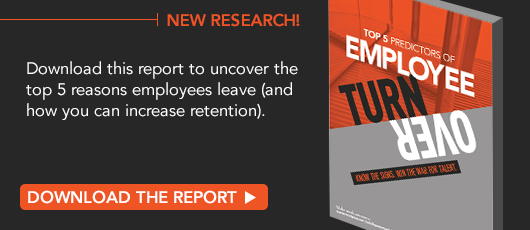How to Use Exit Survey Results to Reduce Employee Turnover
 Turnover is one of the most dangerous threats to any organization. It's incredibly costly, as recruiting, hiring, and training requires time and money most organizations don't have to spare.
Turnover is one of the most dangerous threats to any organization. It's incredibly costly, as recruiting, hiring, and training requires time and money most organizations don't have to spare.
When an employee departs, their exit survey leaves behind clues that expose holes in strategy or how the organization approaches employee engagement. This data displays how the organization can reduce employee turnover in the future—but HR and managers have to know how to read it and take action.
The four steps below will help your organization transform exit survey data into an actionable plan to reduce employee turnover.
1. Start with the results.
Before forming an action plan, really dig into what the exit survey results are telling you. Where does the trail of bread crumbs lead? HR and managers should meet face to face (or over video) to create an open dialogue, ask questions, and make comments that add color and depth to the data. Manager input provides more clarity into why employees leave and what impact their departures have on the team.
2. Examine aggregate trends.
Reviewing the reports without context will likely have little impact. While managers are intensely focused on the health of their team, HR has a wider view of organizational and industry trends. By sharing comparative numbers from similar companies or competitors and other departments or teams in the organization, HR can help managers get a sense of where their teams stand and why turnover occurs.
Managers may feel that the reasons for their turnover are unique, but it could be a part of a larger trend in the organization. Providing context works both ways: if managers aren't used to turnover, it will help calm their fears. But if their teams are experiencing higher turnover rates, HR has some context to bring to tough conversations.
3. Set next steps.
Once managers understand why employee leave, the focus shifts to future action. HR should provide tips about how other teams deal with turnover, or share well-documented national success stories. Arming managers with useful information helps alleviate confusion or frustration by turnover. Create strong action plans that help managers take steps to keep employees around.
4. Encourage the manager to utilize 1-on-1s and feedback to further the conversation with their team.
When employees leave, managers may feel they need to take on the vacated responsibilities until new employees are hired, causing unnecessary stress. HR should encourage them to speak with other team members to generate ideas on how to break up the workload and how to move forward in the interim. It's a team effort, so all parties be a part of the conversation.
Of course, organizations would like to avoid these steps completely and keep as many employees as possible. To do so, you have to spot the warning signs that suggest an employee may leave. Learn how by downloading our free ebook, the Top 5 Predictors of Employee Turnover.







